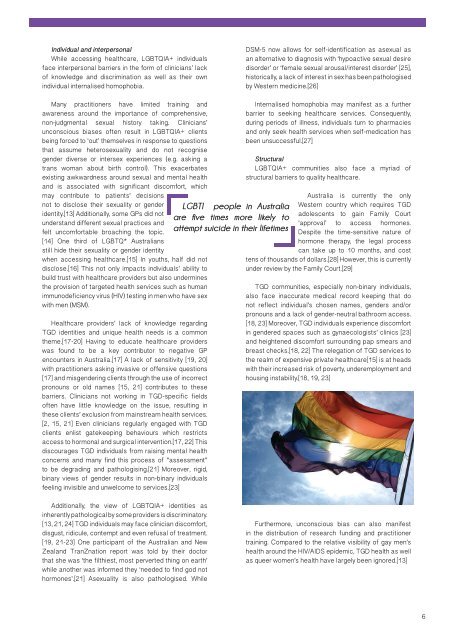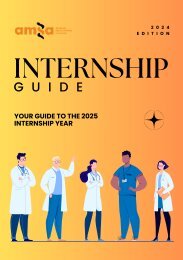Vector Volume 11 Issue 2 - 2017
You also want an ePaper? Increase the reach of your titles
YUMPU automatically turns print PDFs into web optimized ePapers that Google loves.
Individual and interpersonal<br />
While accessing healthcare, LGBTQIA+ individuals<br />
face interpersonal barriers in the form of clinicians’ lack<br />
of knowledge and discrimination as well as their own<br />
individual internalised homophobia.<br />
DSM-5 now allows for self-identification as asexual as<br />
an alternative to diagnosis with ‘hypoactive sexual desire<br />
disorder’ or ‘female sexual arousal/interest disorder’ [25],<br />
historically, a lack of interest in sex has been pathologised<br />
by Western medicine.[26]<br />
Many practitioners have limited training and<br />
awareness around the importance of comprehensive,<br />
non-judgmental sexual history taking. Clinicians’<br />
unconscious biases often result in LGBTQIA+ clients<br />
being forced to ‘out’ themselves in response to questions<br />
that assume heterosexuality and do not recognise<br />
gender diverse or intersex experiences (e.g. asking a<br />
trans woman about birth control). This exacerbates<br />
existing awkwardness around sexual and mental health<br />
and is associated with significant discomfort, which<br />
may contribute to patients’ decisions<br />
not to disclose their sexuality or gender<br />
identity.[13] Additionally, some GPs did not<br />
understand different sexual practices and<br />
felt uncomfortable broaching the topic.<br />
[14] One third of LGBTQ* Australians<br />
still hide their sexuality or gender identity<br />
when accessing healthcare.[15] In youths, half did not<br />
disclose.[16] This not only impacts individuals’ ability to<br />
build trust with healthcare providers but also undermines<br />
the provision of targeted health services such as human<br />
immunodeficiency virus (HIV) testing in men who have sex<br />
with men (MSM).<br />
Healthcare providers’ lack of knowledge regarding<br />
TGD identities and unique health needs is a common<br />
theme.[17-20] Having to educate healthcare providers<br />
was found to be a key contributor to negative GP<br />
encounters in Australia.[17] A lack of sensitivity [19, 20]<br />
with practitioners asking invasive or offensive questions<br />
[17] and misgendering clients through the use of incorrect<br />
pronouns or old names [15, 21] contributes to these<br />
barriers. Clinicians not working in TGD-specific fields<br />
often have little knowledge on the issue, resulting in<br />
these clients’ exclusion from mainstream health services.<br />
[2, 15, 21] Even clinicians regularly engaged with TGD<br />
clients enlist gatekeeping behaviours which restricts<br />
access to hormonal and surgical intervention.[17, 22] This<br />
discourages TGD individuals from raising mental health<br />
concerns and many find this process of “assessment”<br />
to be degrading and pathologising.[21] Moreover, rigid,<br />
binary views of gender results in non-binary individuals<br />
feeling invisible and unwelcome to services.[23]<br />
LGBTI people in Australia<br />
are five times more likely to<br />
attempt suicide in their lifetimes<br />
Internalised homophobia may manifest as a further<br />
barrier to seeking healthcare services. Consequently,<br />
during periods of illness, individuals turn to pharmacies<br />
and only seek health services when self-medication has<br />
been unsuccessful.[27]<br />
Structural<br />
LGBTQIA+ communities also face a myriad of<br />
structural barriers to quality healthcare.<br />
Australia is currently the only<br />
Western country which requires TGD<br />
adolescents to gain Family Court<br />
‘approval’ to access hormones.<br />
Despite the time-sensitive nature of<br />
hormone therapy, the legal process<br />
can take up to 10 months, and cost<br />
tens of thousands of dollars.[28] However, this is currently<br />
under review by the Family Court.[29]<br />
TGD communities, especially non-binary individuals,<br />
also face inaccurate medical record keeping that do<br />
not reflect individual’s chosen names, genders and/or<br />
pronouns and a lack of gender-neutral bathroom access.<br />
[18, 23] Moreover, TGD individuals experience discomfort<br />
in gendered spaces such as gynaecologists’ clinics [23]<br />
and heightened discomfort surrounding pap smears and<br />
breast checks.[18, 22] The relegation of TGD services to<br />
the realm of expensive private healthcare[15] is at heads<br />
with their increased risk of poverty, underemployment and<br />
housing instability.[18, 19, 23]<br />
Additionally, the view of LGBTQIA+ identities as<br />
inherently pathological by some providers is discriminatory.<br />
[13, 21, 24] TGD individuals may face clinician discomfort,<br />
disgust, ridicule, contempt and even refusal of treatment.<br />
[19, 21-23] One participant of the Australian and New<br />
Zealand TranZnation report was told by their doctor<br />
that she was ‘the filthiest, most perverted thing on earth’<br />
while another was informed they ‘needed to find god not<br />
hormones’.[21] Asexuality is also pathologised. While<br />
Furthermore, unconscious bias can also manifest<br />
in the distribution of research funding and practitioner<br />
training. Compared to the relative visibility of gay men’s<br />
health around the HIV/AIDS epidemic, TGD health as well<br />
as queer women’s health have largely been ignored.[13]<br />
6

















